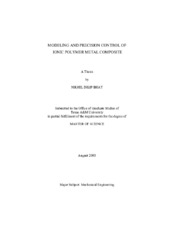| dc.description.abstract | This thesis describes the open-loop behavior of an ionic polymer metal composite (IPMC) strip as a novel actuator, the empirical force and position models, the control system and the improved dynamic characteristics with the feedback control implemented. Ionic polymer metal composite is a novel polymer in the class of electroactive polymers. IPMC consists of a base polymer coated with electrodes made up of highly conducting pure metals such as gold. The actuation behavior of IPMC can be attributed to the bending of an IPMC strip upon application of voltage across its thickness. The main reasons for the bending are ion migration on the application of voltage and swelling and contraction caused by water content. An experimental setup to study the open-loop force and tip displacement of an IPMC strip in a cantilever configuration was developed, and real time controllers were implemented. In open loop, the force response of the IPMC strip of dimensions 25 mm x 3.9 mm x 0.16 mm to a 1.2-V step input is studied. The open-loop rise time was 0.08 s and the percent overshoot was 131.62 %, while the settling time was about 10 s. Based on this open-loop step response using a least-square curve-fitting methodology, a fourth-order empirical transfer function from the voltage input to the force output was derived. The tip displacement response of an IPMC strip of dimensions 23 mm x 3.96 mm x 0.16 mm to a 1.2-V step input was also studied. The step response exhibited a 205.34 % overshoot with a rise time of 0.08 s, and the settling time was 27 s. A fourth-order empirical transfer function from the step input to the tip displacement as output was also derived. Based on the derived transfer functions lead-lag feedback controllers were designed for precision control of both force and displacement. The control objectives were to decrease the settling time and the percent overshoot, and achieve reference input tracking. After implementing the controllers, the percent overshoot decreased to 30% while the settling time was reduced to 1.5 s in case of force control. With position control, the settling time was reduced to 1 s while the percent overshoot decreased to 20%. Precision micro-scale force and position-control capabilities of the IPMC were also demonstrated. A 4 ?N force resolution was achieved, with a force noise of 0.904-?N rms. The position resolution was 20 ?m with a position noise of 7.6-?m rms. | en |


